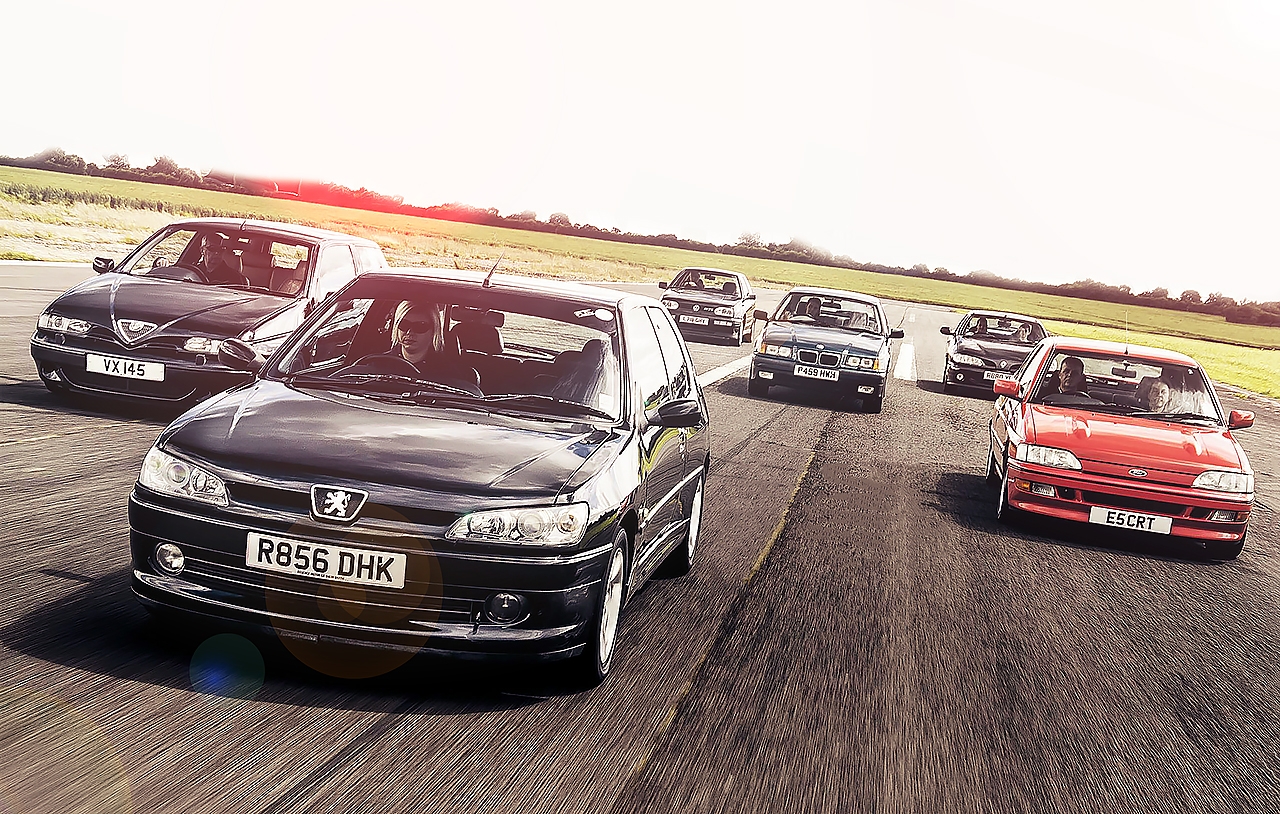
The greatest hot hatch of the 1990s? We put the Peugeot 306 GTI-6 up against its rivals. Why 1990s beats ’80s How Peugeot’s £2k 306 GTI-6 rewrites hot hatch history… Great pretenders. Six brilliant hot hatches that prove the 1990s were a golden era in affordable performance cars. And they remain so to this day. Peugeot 306GTi-6 20th Anniversary. The Peugeot 306 GTI-6 hits 20. Time to take a fresh look at the cream of the 1990s hot hatch crop – are these the real champs? Words: Ross Alkureishi. Photos: Laurens Parsons.
If you believe the ho- hatch wars began and ended in the 1980s, think again. After a lull in demand because of the early-’90s recession, and a massive rise in affordable coupe sales, battle recommenced with a more polished line-up of protagonists. Of the new generation, the 1996 Peugeot 306 GTI-6 truly reset the hot-hatch chronometer. It took the driving genius of the 205 GTI and significantly improved its formula, adding tighter build quality, more mature dynamics and better performance for the next generation.
Although you might not know it, the 1990s were the time that the hot hatch truly came of age – we simply didn’t know it at the time. Time to put the best of the ‘new breed’ to the test – and see that the 306 doesn’t have the game completely to itself…
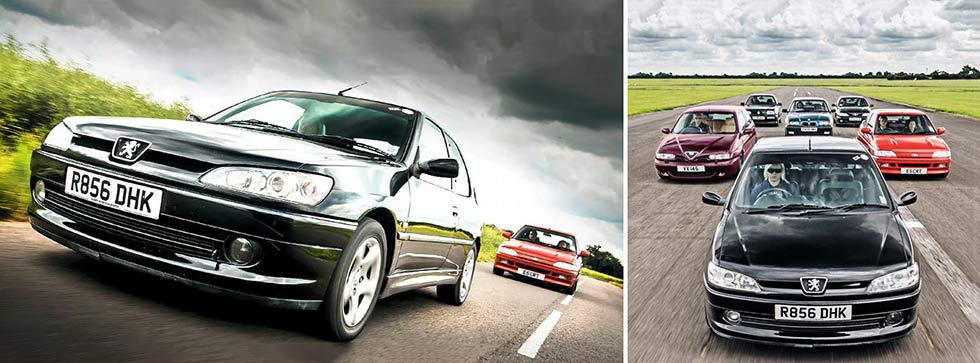
Peugeot 306 GTi-6 vs. BMW 318ti Compact E36, Ford Escort RS2000, Alfa Romeo 145 Cloverleaf, Renault Megane 2.0 16V and Volkswagen Golf GTi MkIII test drive
ALFA ROMEO 145 CLOVERLEAF
Why it’s here Concept car styling and a terrific twin-cam give this a shot at hot-hatch greatness.
Standing in front of this Alfa Romeo is a rather thought-provoking experience. OK, so it’s not traditionally pretty, like our 306, but the longer you spend with its bread van design, the more it grows on you. It’s best viewed in profile where, despite a number of overly fussy creases and swages, it looks most resolved.
Pop the door, and you encounter an interior superior to anything else in this group – even the BMW’s. The seats and door trims are clad in tan hand-stitched leather, with the former embossed with the company’s logo, and provide a quite exquisite contrast to the exterior. There are other satisfying design touches, such as the glove compartment that scallops in, according the passenger more space.
Seated, there’s a slight pedal offset, but the chrome-rimmed instrument binnacle and other controls are well placed – even if you do sit a mite too high. Visibility is incredible, as is cabin size. The only incongruous item is the huge black gearlever, which looks like something you might beat a gangster to death with in a Cockney crime movie.
Despite its size it shifts with quick snicks, rather than the Ford Transit sogginess your brain’s prepared you to experience. Yet, it’s the Twin-Spark 2.0-litre engine – which came from the 155 saloon – that’s vaulted immediately to the fore as the star. If you’ve never experienced a good Italian four-pot, then you’ve missed out on the ability of that country’s motoring engineers to make them sing.
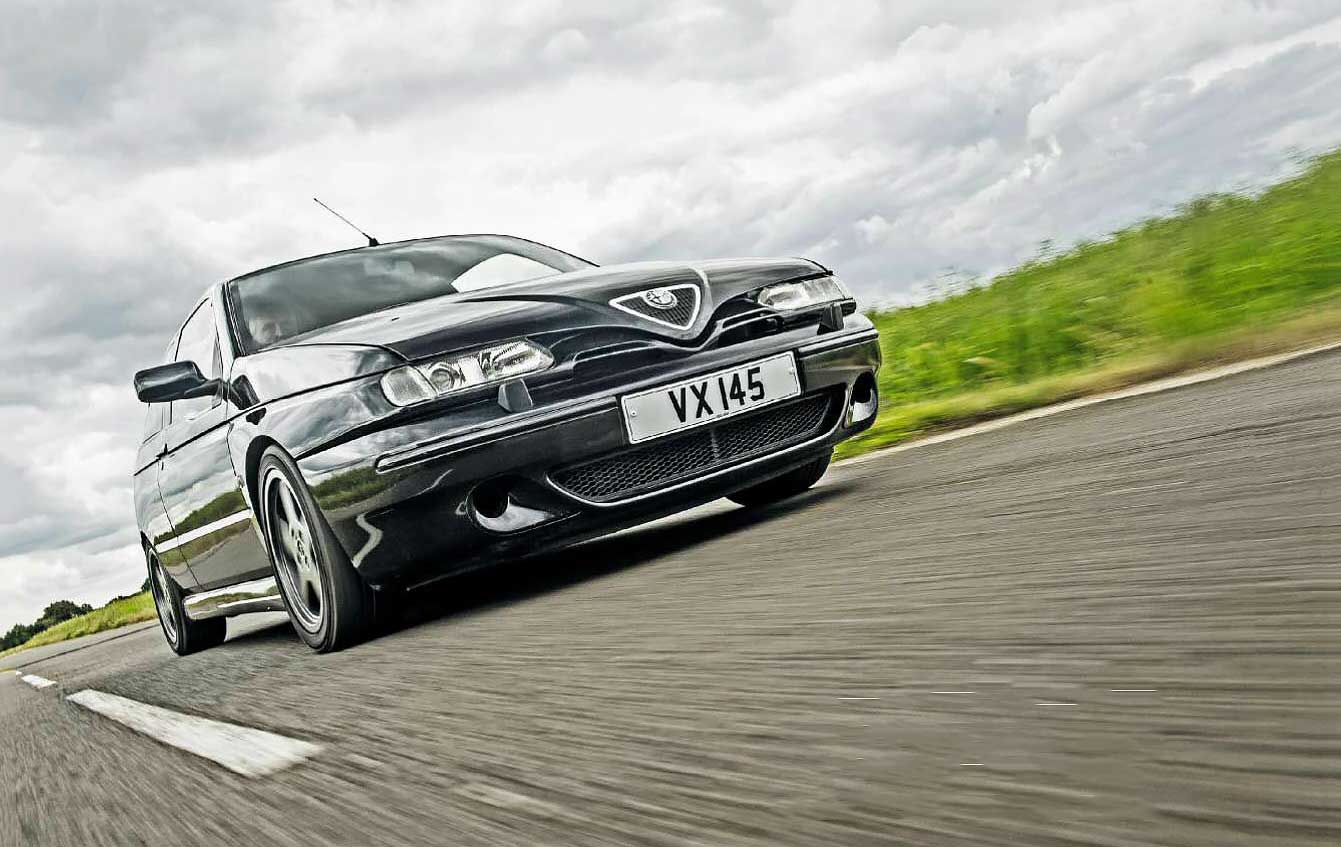
Alfa Romeo 145 Cloverleaf road test
The 306’s torquey unit feels positively asthmatic by comparison; where it pulls brutally, the Alfa’s fizzes freely as the rev counter spins ever higher. It’s a completely different type of accelerative, and sonorous, high.
Despite a lower power output of 155bhp, lighter weight means it’s slightly quicker than the 306, with the 0-60mph sprint covered in 7.8 seconds. In the braking department it’s again superior to all, with excellent pedal bite and superb retardation allowing you to brake much later into corners.
That’s where the Pug nails a standard car, though. The Alfa’s chassis dynamics are very good, but simply not in the same elevated class. While its steering – at just 2.4 turns lock-to-lock – means low-speed manoeuvrability is excellent, at speed it’s a tendency towards the hyperactive.
Without suspension mods, a 145 rolls considerably. You’ll still be trying to counteract this as the 306GTI-6 nips through on the inside and the driver waves tatty-bye. But Lee Foulser’s example has Koni dampers, Eibach springs and anti-roll bars fitted, so it’s a much closer-run thing.
It also lacks a little of its rival’s ride civility, with rougher roads leaving you a bit ruffled – even more so here. However you can forgive it anything for that engine, and the musical noise it makes under heavy load.
With asking prices ranging from £500 for a runner to £2500 for the very best, only those in the know appreciate just what a little gem the 145 Cloverleaf is.
An Alfa Romeo defined by its styling and engine? There’s nothing new in that – but this one’s enhanced in the handling department, too, thanks to thoughtful suspension mods.
‘You can forgive it for anything for that engine and the musical noise it makes under acceleration’
BUYING INTEL
‘This was a customer car, which we turned into a track car for the owner. All the time we looked after it, I said “if you ever sell it let me know…” Finally, I got the call, and have had it for two years,’ says Maidenhead-based specialist Alfa Aid’s (alfaaid.co.uk) service manager Lee Foulser.
‘They rust on the floors – even if the rest is good, owners can’t justify spending a grand on the body, and many get scrapped – this example has never been welded. Hard to believe for an Alfa this age, but it it’s always been garaged and regularly undersealed. ‘You should budget about £500- £600 per year to run one, with a big service to do the cambelt every three years – that’ll cost £620 on top. The engines are great and, if you do the belt regularly, are super-reliable. People are starting to take notice of them, as there’s so few about – I think roughly 160 left.’
SPECIFICATIONS Alfa Romeo 145 Cloverleaf / Quadrifoglio
Engine 1970cc/4 cyl/DOHC
Power 155bhp @ 6400rpm
Torque 140lb ft @ 3500rpm
Maximum speed 131mph
0-60mph 7.8sec
Fuel consumption 30-34mpg
Transmission FWD, five-speed manual

Twin-spark twin-cam is peaky, peppy and pushes out a more than handy 155bhp. Good enough for 131mph and 0-60mph in 7.8 seconds.
BMW 318Ti COMPACT E36
Why it’s here Ultimate driving machine always gets a seat at the top table – even in low-powered form.
Here’s a car with styling that divides opinions. In brutally truncated form, the 3-series looked like someone had carried out a hatchet job on its rear end. Has it aged well? You decide. The front end is still immediately recognisable, and from the rear there’s a hint of the Z1’s high boot line, but in profile it’s ungainly.
The designation harks back to the ‘Touring International’ sporting versions of the company’s all-conquering 1960s ‘Neue klasse’ models. And just like them, the E36’s cabin is encompassed by a vast expanse of glass. This ensures superb visibility, but impacts on purity of line – the Alfa performs the same trick but far more successfully.
The cabin is better constructed than the Ford and Frenchies, but by BMW standards is decidedly low-rent and not in the same class as Alfa or Golf. It’s airy, and the light beige finish is pleasing after the dark oppression provided by our French offerings, but the lack of true sports seats is conspicuous in a car with such pretensions.
The eagle-eyed will also spot that this one is hamstrung in this company by a four-speed automatic gearbox. And that’s a shame, as the manual unit is renowned for being direct with a short, sporting throw. Yet, even in that guise, it’d be one of the slowest cars here. This one’s auto-cog shifter adds a further 1.2sec to its 0-60mph time, coming in at a decidedly slovenly 10.8sec.
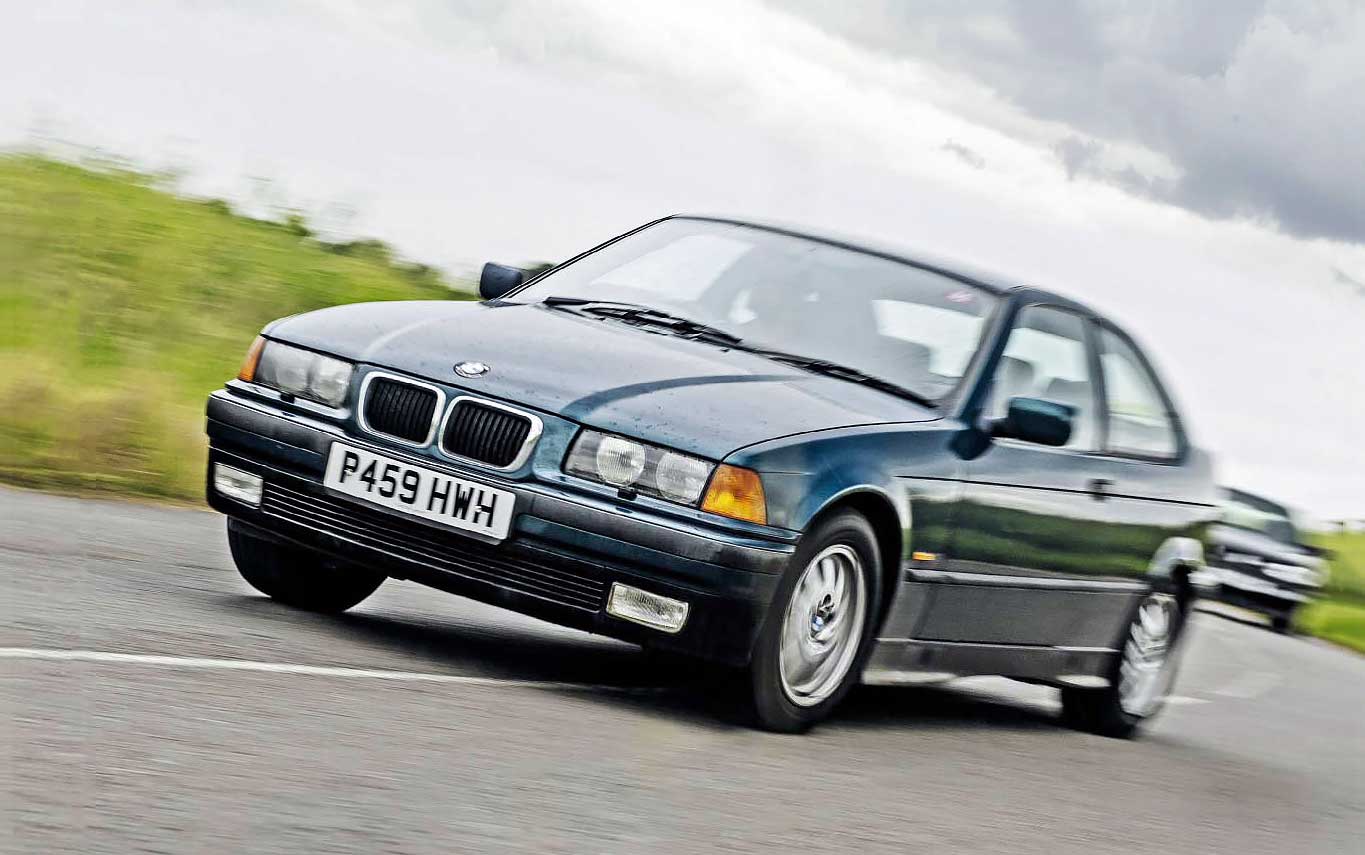
Traction control off, please. OK, now let’s have some old-fashioned rear-wheel-drive fun. The 318Ti is very different to the other cars here, and all the more refreshing for its neutral playfulness.
That’s not to say there isn’t fun to be had here. Yes, the engine excels as a smooth cruiser, but ramp it up a notch and it elicits an agreeable yet always subdued rasp. Acceleration is lukewarm, but sticking it in Sport mode and manually holding the gears at least allows you to utilise the full breadth of available grunt.
Through twisties, it’s orderly, precise and efficient. Push it a bit harder and the semi-trailing-arm rear suspension gets a bit agitated, causing the rear end to skip and skim a little. However, today, here on our private airfield, there’s no excuse for not switching the traction control off.
Doing so transforms the car, allowing full rear-drive playfulness and turning it into an opposite-lock sliding imp of a thing. The steering isn’t quick, but there’s a stack of grip available and you can hustle it through corners in a manner that eradicates any thoughts that this may be a little lardy. Yes, it’s a little undercooked in this company, but most for sale sit comfortably under the £1k barrier. However, if your budget can take it, search out a later 2.5-litre, 168bhp 323ti with a manual gearbox, or even an E46-based Compact.
At least the latter was given unique aesthetics, with its Kamm-tail-esque rear and bonnet-enclosed circular headlights. They won’t hit the spot for everyone, but either will provide a distinctive modern classic and be a decent little performer to boot.
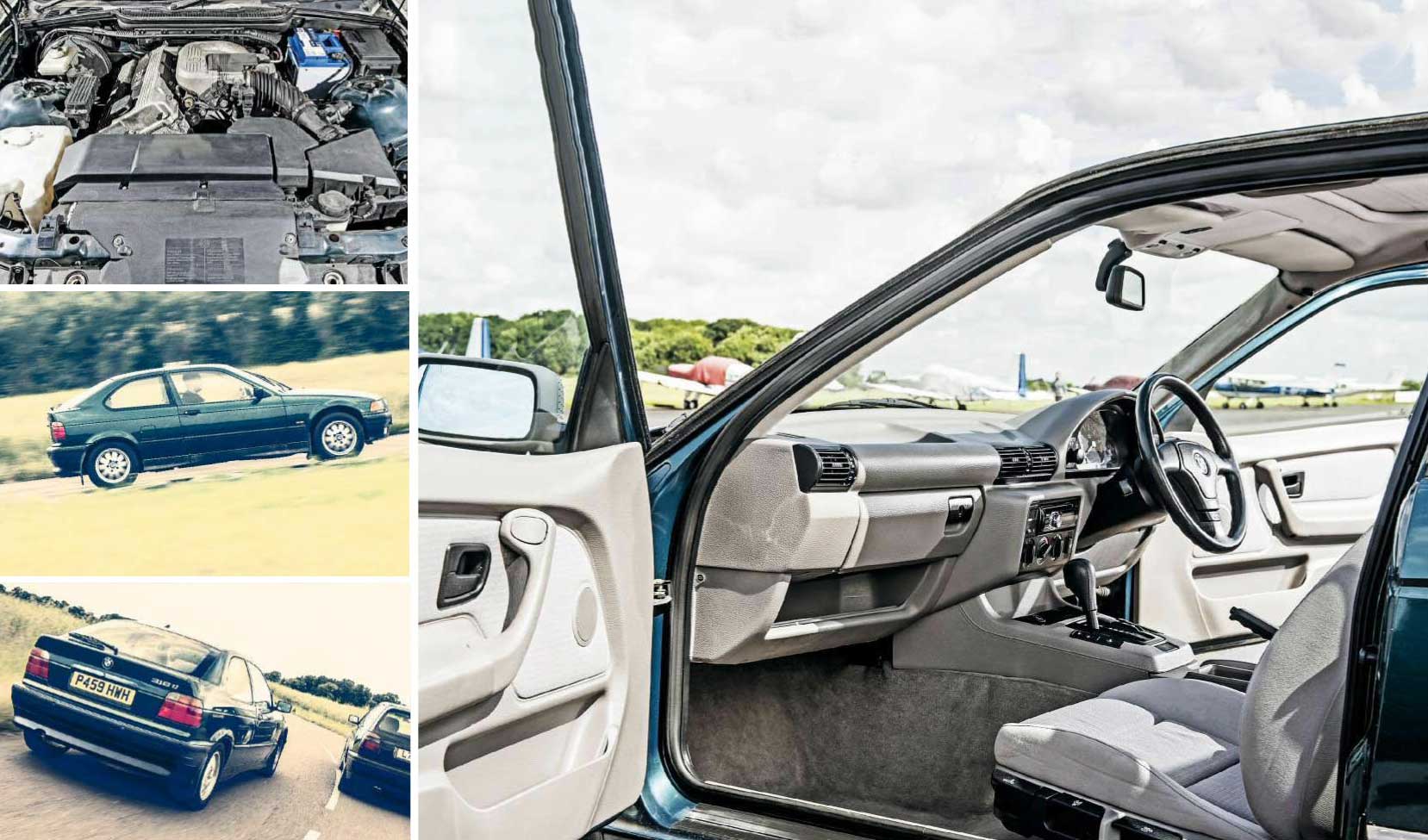
Twin-cam 1.8-litre four-pot is a lively little unit, but slightly out-gunned in this company. Very good reliability and a doddle to service.
BUYING INTEL
‘It’s based on the E30/36 generation so is pretty reliable,’ says Andy Walker of West Sussex based specialist, Walkers Autotech (walkersautotech.co.uk). ‘Parts are cheap and it’s simple to repair. The engine is pretty bombproof.
They do leak oil from timing covers and sump gasket area and there’s the occasional ignition coil failure.
‘The gearbox is indestructible, differential reliable, the clutch is good for 100k miles, but the propshaft coupling needs replacing quite often – £134 fitted. Rear wheelarches rust, and rear wheel bearings – £204 fitted, each – are a common failure. The front to rear metal brake lines corrode and are expensive to replace – £660 – as they run above and around the fuel tank. ‘About £800 will buy a reasonable car, but you can expect to pay up to £3000 for a lovely example.’
SPECIFICATIONS BMW 318ti Compact E36
Engine 1796cc/4 cyl/DOHC
Power 140bhp @ 6000rpm
Torque 133lb ft @ 4300rpm
Maximum speed 130mph
0-60mph 10.8sec
Fuel consumption 33-37mpg
Transmission RWD, four-speed automatic ZF4HP
{module BMW E36}
FORD ESCORT RS2000
Why it’s here Unfair to say ‘because it’s an RS’, as it’s not widely known just how good these cars are
There’s a certain smell that old fast Ford interiors emit. It’s a combination of aged fabric and plastics, allied to the gentlest whiff of petrol and driver’s exertion. And this car is no different. Breathe in its familiarity as you lower your backside into the velour Recaro seat. No leather here – it’s a Ford, don’t you know. You sit pleasantly lower than in the other cars here, lending proceedings a sportier air. It’s further accentuated by the view down the bonnet, with its narrow twin bonnet bulges. If you didn’t see them and you quickly caught your reflection in a shop window, you’d be forgiven for thinking you were ensconced in a standard car.
If you think Volkswagen caught it in the neck for the 8v GTI’s lack of fizz, then the boggo 1990-on Escort – with its Uninspiring CVH engines and ultra-dull dynamics – caused uproar in the media .Ford dropped the ball, and it knew it. So, amends were made rapidly and the 1992 RS2000 redressed the balance in impressive style. In came an all-new 2.0-litre, 16-valve unit based on the DOHC Sierra 8v engine, kicking out a useful and torquey 148bhp.Heavily revised suspension and steering completed the package. Initially the anti-lock brakes feel uninspiring – certainly compared to the Alfa’s – but once you get used the bite, they pull the RS up tidily. The gearshift is vague, and has you wishing the engineers had utilised some design insight from RS1600 and 2000s of old. However, the engine is thoroughly willing and pulls you along lustily on a wave of revs.

Forget the sogginess of the standard 1990-on Escort – the RS2000 is superb on the road, with tight handling and excellent performance. It’s also a comparative bargain in the RS arena.
All your worries about this not being a proper RS disappear when you start driving harder. Appreciation comes in the first twist, as you tuck it in tightly, and it hoons round, firmly planted. Further attacks allow you to hone your entry and exit strategies, and it never feels like it’s going to bite you – back in Dagenham, the fine work done on that chassis must surely have regained some measure of model pride. The soundtrack isn’t as harsh as the Pug’s and Renault’s, or fizzy as the Alfa’s, but it forges its own strident note, and matches the urgent character of the car.
It’s not quite in the 306 GTI-6 class – none of our cars really come close to matching that car’s magical blend of balance and handling – but it can hold its own in the rest of this company. And you can actually fit two adults in the rear, so as a modern family classic it ticks all the boxes.
‘You can pick up a runner needing work from £2k – anything below that is likely to be very poor,’ says Ford RS Owners’ Club marque registrar Derek Higgs. ‘You’ll pay up to £10k for a concours example. There aren’t many for sale because the majority weren’t looked after and they die of tin worm and neglect, so patience is needed to find a good one.’
You also get motorsport kudos with this car, as Gwyndaf Evans romped to the F2 Rally Championship in 1996. But the best bit is that it lives comfortably in the shadow of the Escort Cosworth and RS Turbos, and while those big beasts hog the limelight the discerning modern fast Ford fan can sidestep into one of the last truly affordable RSs.
BUYING INTEL
‘It’s often overlooked, and is one of the last affordable RSs. You can pick up a runner needing work from £2k,’ says Ford RS Owners’ Club (rsownersclub. co.uk) MkV and MkVI registrar, Derek Higgs. ‘Patience is needed to find a good one. The major thing to check is rust – rear wheelarches, tailgate, chassis rails, sills, A-pillar and fuel cap area. Polished MkV alloys also suffer from weathering.
‘Mechanically, there are no real issues, other than normal checks. Fuse boxes can suffer water leaks, the coil pack wiring can degrade and the idle speed control valve can get gummed up, leading to erratic idling. The bodywork is potentially the most costly to do properly, and is hugely time-consuming as many panels are tough to find. But other stuff isn’t that expensive. Some genuine new parts – such as trim – are difficult to source, as they’re no longer available.’
SPECIFICATIONS Ford Escort RS2000
Engine 1998cc/4cyl/DOHC
Power 148bhp @ 6000rpm
Torque 140lb ft @ 4500rpm
Maximum speed 133mph
0-60mph 8.4sec
Fuel consumption 25-29mpg
Transmission FWD, five-speed manual
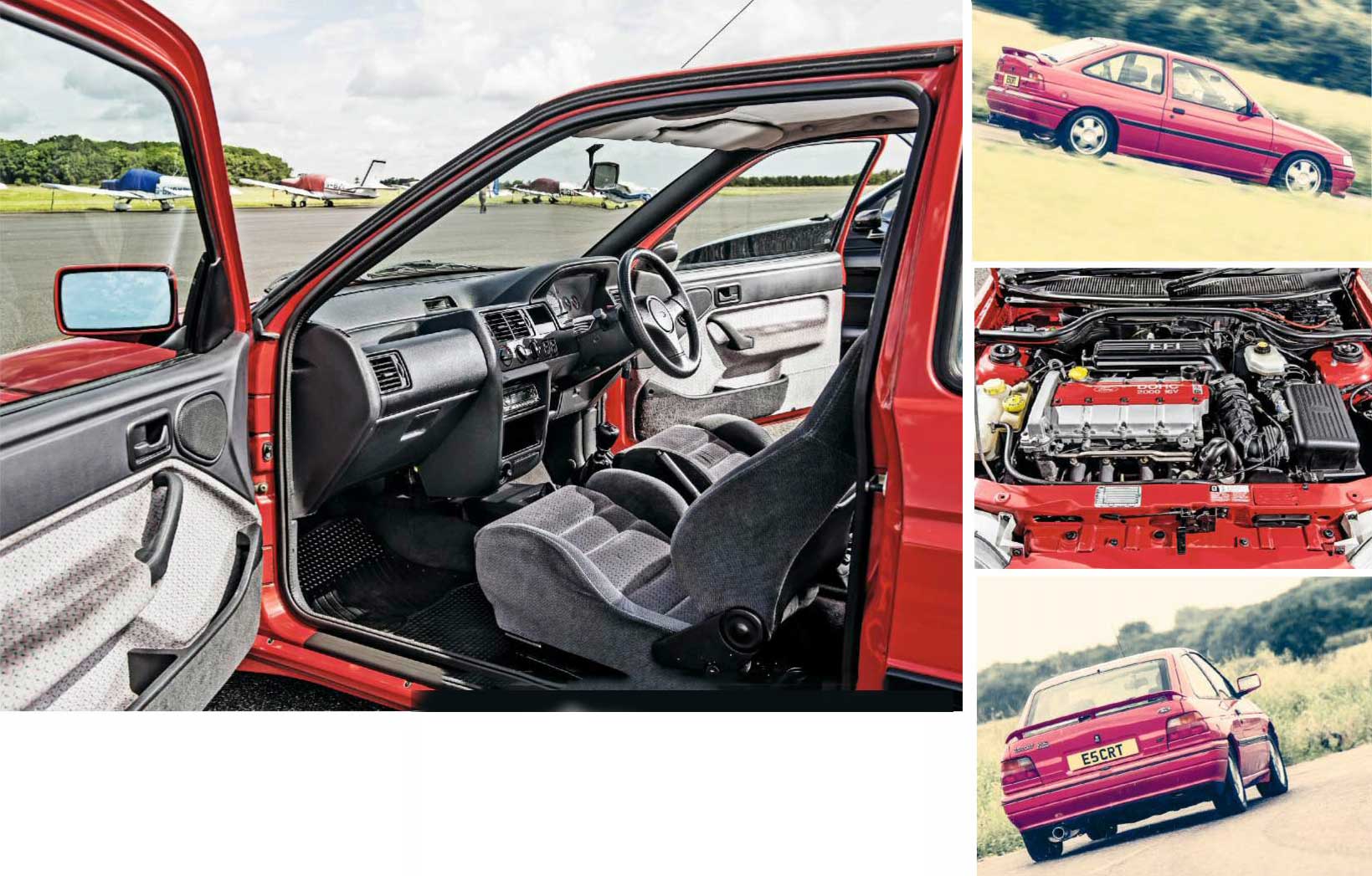
Sierra-sourced 2.0-litre engine punches out a useful 148bhp, meaning 60mph is a thing of the past after 8.4 seconds.
PEUGEOT 306 GTI-6
Why it’s here This was the hot hatch to uphold this market sector’s honours. And it’s still that good.
If the previous decade’s hot hatches wore their performance upgrades with pride, then those that followed did it more discreetly. Take theGTI-6: its Pininfarina styling has definite 205 roots, but only the subtlest of badges give the performance game away. So is visual prudence reflected in driving experience? Perish the thought. Plant the throttle, and the emblem on the bonnet is propelled forward like a lion on a mission. The 2.0-litre, 16-valve engine comes alive at 3000rpm and roars through 4000rpm to redline at 7200rpm. Its vicious level of punch is matched by a hard-edged soundtrack.
The ‘6′ of the model moniker is indicative of cogs. And it provides the joy of six, in terms of a tight ratio spread that allows you to keep the powerplant always on cam– even if it is a little notchy. Allied to what amounts to an overdrive top gear, and the car is as at home ticking over gently on the motorway as it is on full-on B-road attacks.
And my, what fun they are. Tuck it tight and hard into a corner, and the back end steps out, but rectifying it with a dab more power and touch less lock is an intuitive delight. The front-wheel-drive chassis is lithe, and you’re aided throughout by passive rear-wheel steering. Despite being power-assisted, steering feedback is always spot-on. The only problem is the manner in which the 306GTI-6 goads you to drive it: namely, flat-out. It’ll devour 0-60mph in 8.1 seconds and run up to 135mph. Luckily, the anchors – with ABS and ventilated discs up front – are up to the job.

Peugeot 306 GTi-6 road test. The car in front is a Ford – but the one that’ll get you there more quickly is the Peugeot. The 306 GTI-6 is a masterclass in springing, damping and driver feedback. Why did they stop building cars like this for so long?
For all its hardcore character, the surprise is that as a town cruiser it’s more than adept. Unlike modern performance hatches, which forego comfort for handling with rock-hard suspension set-ups, it soaks up road imperfections beautifully, with the most considered springing and damping. There are simply no compromises here. Although, be warned, its turning circle is criminal; a gentle reminder that city slicking is not what this car was primarily designed for.
Visually, it has the tidiest design of our gathered cars. The interior is a bit Pug-tastic, which means lots of plastic – although you do get leather and Alcantara combination sports seats, and it’s a million times better in terms of quality and solidity compared with a 205 or 309.
Yes, with its plethora of driver’s and safety aids, it’s not quite as pure and focused as the original. However, long after you’ve reached the 205 GTI’s hairy limits, its successor will be far off in the distance, romping away from you.
As a classic, the 205 GTI has taken off in recent years, with prices climbing steadily. And according to Matthew Jobling of specialist Pug1off, it’s only a matter of time before its exceptional younger sibling does likewise. ‘GTI-6 prices are at an all-time low, but minters will rise soon, I think. ‘ So it’s cheap to buy, relatively easy to look after and one of the finest handling hot hatchbacks from ever, not just the 1990s. And if you cherish it, you could even make some money on it. What’s stopping you, then?
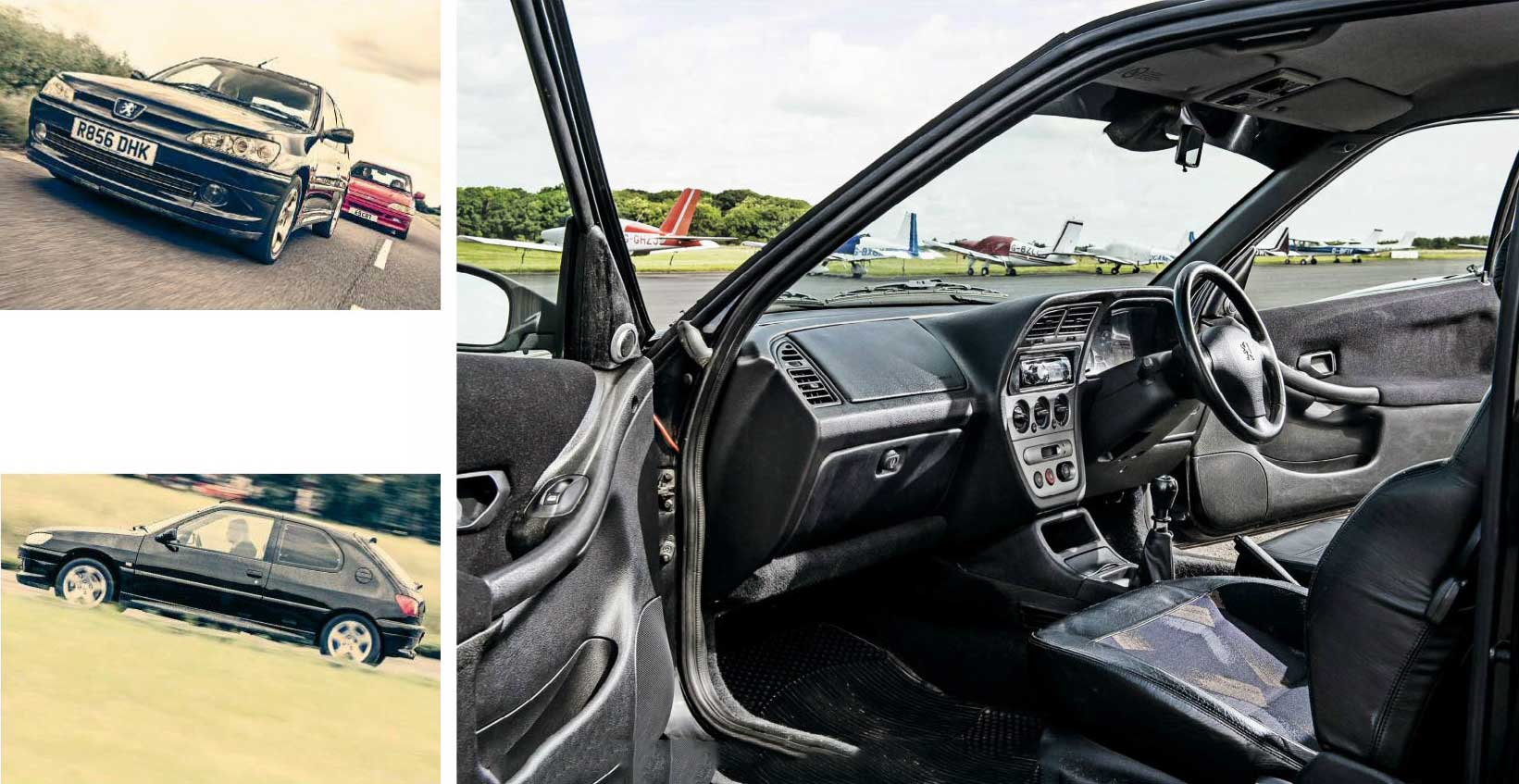
For such an accomplished hot hatch, the 306GTI-6 has suprisingly low-key styling. We really like it this way – a proper design classic, and you don’t know it yet.
BUYING INTEL
‘It’s the best handling – and build quality – ever from Peugeot,’ says Matthew Jobling of Brackley-based specialist Pug1Off (pug1off.com). ‘With, I think, their most powerful, tunable, engine. ‘Prices start at a £500 lottery, up to £2.5k-£3k for a nice Rallye or really-low-mileage mint GTI-6. It’s getting rare to find good ones, as anything under £600 is bought up for the engine and running gear.
‘Reliability-wise they’re not too bad. They suffer the occasional minor idling issue but rear axle play is the most likely problem; it’s £720 for a rebuild. We’re seeing more with rust in the front wheel arches and front floor at the box sections behind the subframe. Clutches can go stiff and need replacing at £552, and the cambelt and water pump need done every 60k-miles.
‘I’d advise spending a minimum of £1000 on a car, allow another £1000 for any repairs, and from there servicing and extras might cost £250-£400 per year – but how long is a piece of string?’
SPECIFICATIONS Peugeot 306 GTi-6
Engine 1998cc/4 cyl/DOHC
Power 167bhp @ 6500rpm
Torque 142lb ft @ 5500rpm
Maximum speed 135mph
0-60mph 8.1sec
Fuel consumption 28-32mpg
Transmission FWD, six-speed manual
RENAULT MÉGANE 2.0 16V
Why it’s here Rare and wonderful today, and an absolute driver’s delight. When did you last see one?
Try finding an unmodified Mégane 2.0 16v Coupé. In fact, try finding an example, period. ‘I can’t remember the last time I saw one!’ says Renault UK communications director Jeremy Townsend. There are none in the owners’ club. So, how has a car that regularly topped the UK Coupé sales chart almost become a vehicle of myth in such a short space of time?
There’s a simple answer: Max Power. It took us a month to find this one, and even then owner Kristofer contacted us the night before the photoshoot. The bodykit tragedies that were visited upon coupés are the stuff of nightmares, and as for the semi-clad lassies draped across bonnets…
No wonder – as depreciation kicked in, the modding vultures circled. Couple this with a surprisingly low insurance rating – like all the other cars here, rapacious insurance premiums saw the manufacturer trying to discreetly package its performance wares – and a match made in automotive survival hell was made.
Here in standard form it’s a relatively smart beast. At launch, some thought it odd-looking, but the front three-quarter profile is imposing and dynamic with that be-winged bonnet swoop dominating. Yes, at the rear, it all gets a little bit bulbous and bug-eyed, but again, place yourself behind the wheel and all is forgiven.
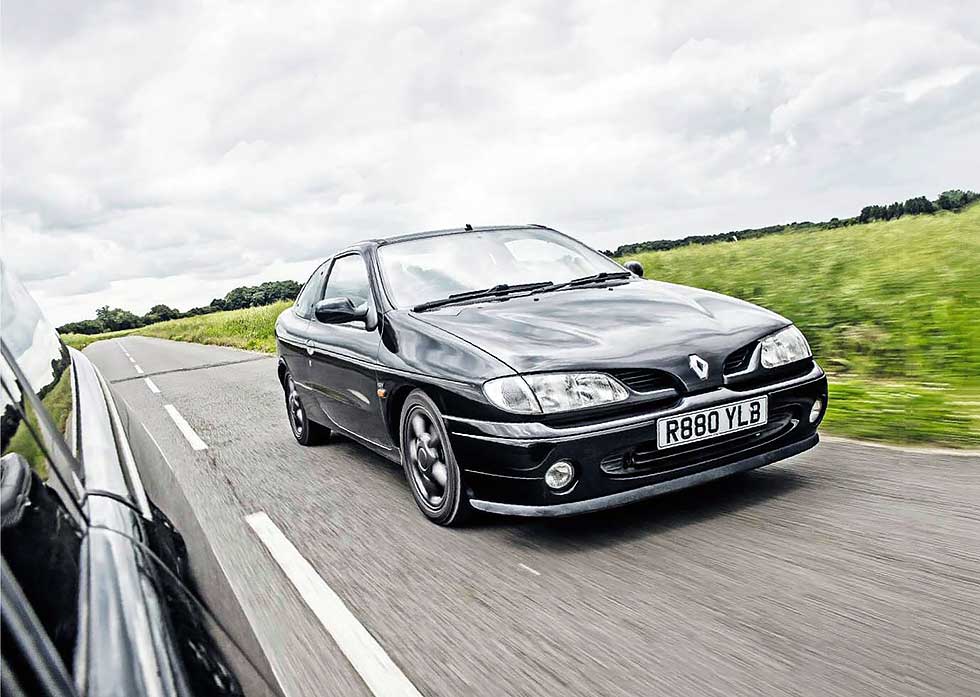
Renault Megane 2.0 16V road test. It might look disjointed, but the way it flows on the road is an absolute joy. The Mégane Coupé is fast, grippy and responsive, and gives the 306GTI-6 a proper run for its money.
And this rare survivor demonstrates exactly why. With 148lb ft on tap, it’s the torquiest lump here, and with an evenly spread power band it doesn’t lack for low-end pull.
Drop the sweet short-shift gearchange, nail the throttle and there’s a guttural wail that’s as hard as the Peugeot’s. This is one hot hatch. Except it’s not; it’s a two-door with a boot. Oh well, artistic licence, and all that. The extra body rigidity is felt in the handling, which is communicative and grippy. That shouldn’t come as a complete surprise; these were made by the boys responsible for the Clio Williams.
The steering through the chunky sports wheel is precise, and it nips through bends with a well-engineered level of agility. It’s a car that quickly lends you confidence, and inspires you to ramp things up a notch. Being more liberal with your right foot, the engine gets supremely frisky.
While the Pug’s cabin is discreet, the Alfa’s sophisticated and the Volkswagen’s indestructible, the Mégane’s is garish. The different-coloured moulded plastic seems mismatched, and bringing the Jackson Pollock seat and door card trim into play doesn’t help matters – it’s definitely an environment best sampled with eyes firmly shut.
Luggage space is poor, and you’ll also struggle to get anyone comfortably in the rear +2 seats. But then why would you want to? This car is about the person in the driver’s seat. Thanks to a supple ride it’ll easily pootle around town, but the sight of every speed de-restriction sign will have you salivating, then nailing the throttle. There isn’t a market for them right now, so bagging one is down to vigilance and luck. Crack that, and you too can experience the original Fat Bottomed Girl.
‘Drop the short-shifter, nail the throttle and there’s a guttural wail that’s as hard as the Peugeot’s’
BUYING INTEL
‘These cars are hugely underrated. However, there’s very little that goes wrong on them,’ says Tom Barker, of Newcastle-based Renault specialist, TW&S Barker (barker-renault.co.uk). ‘The engine is phenomenal and built in a way that nothing needs adjusting – just oil and the timing belt changing every 72,000 miles or five years, although if that’s been neglected then there will be more serious issues. ‘One 2.0-litre 16v-specific problem is the engine sensors can go wrong – it won’t pull, as the pressure drops off – and Renault stopped making them, so you need to look for a car being broken to get spare parts. Other than that it’s just ball joints (£20 a pop) or general wear-and-tear items such as track rod ends. Most non-body-specific parts are interchangeable between the Coupé and standard Mégane, and most parts are available from factors.’
SPECIFICATIONS Renault Megane 2.0 16V
Engine 1998cc/4cyl/DOHC
Power 140bhp @ 5500rpm
Torque 148 lb ft @ 4250rpm
Maximum speed 133mph
0-60mph 8.4sec
Fuel consumption 31-35mpg
Transmission FWD, five-speed man

The Renault F7R 16-valver is practically bulletproof n the Mégane. It’s punchy, sounds good, and serves up enough performance to keep the more powerful 306 honest.
VOLKSWAGEN GOLF GTI
Why it’s here This car’s ancestor all but created the market sector – and the MkIII is still great value.
GTI and Volkswagen – a model designation and automotive brand destined to be entwined forever, their relationship formed by the mould breaking MkI and cemented by the excellent MkII. Yet, like the best of us, an inevitable spiral into flabby middle age followed with the later models.
Ah, MkIII GTI, in 115bhp eight-valve guise… you were always destined to receive a pasting. Safer and bigger meant lardier, and despite being better built than its predecessors, the fact that it pushed out just 115bhp meant it was never going to win over model connoisseurs. In the hot hatch world, evolution should never ever equate to slower… Hotter examples followed in the form of the 16-valveGTI and VR6-engined cars. Both certainly went someway to righting the these wrongs. So where does that leave us now?
Well, if truth be told, with a bit of a bargain. This immaculate 54,000-mile, two-owner MkIII (on sale at milestoneclassics.co.uk) is up for £4495. In the GTI hierarchy, the 8V is always likely to figure towards the bottom of the food chain, but it’s time for a reassessment. Yes, the subtle curving of its boxy profile resulted in a softer figure, and the amalgamation of its quad headlamps into two was tantamount to an ITN producer telling Sir Trevor McDonald to ditch his spectacles for the next broadcast. But today, unlike its firmly ‘classic car’ lodged predecessors, it retains a distinctly modern aesthetic.
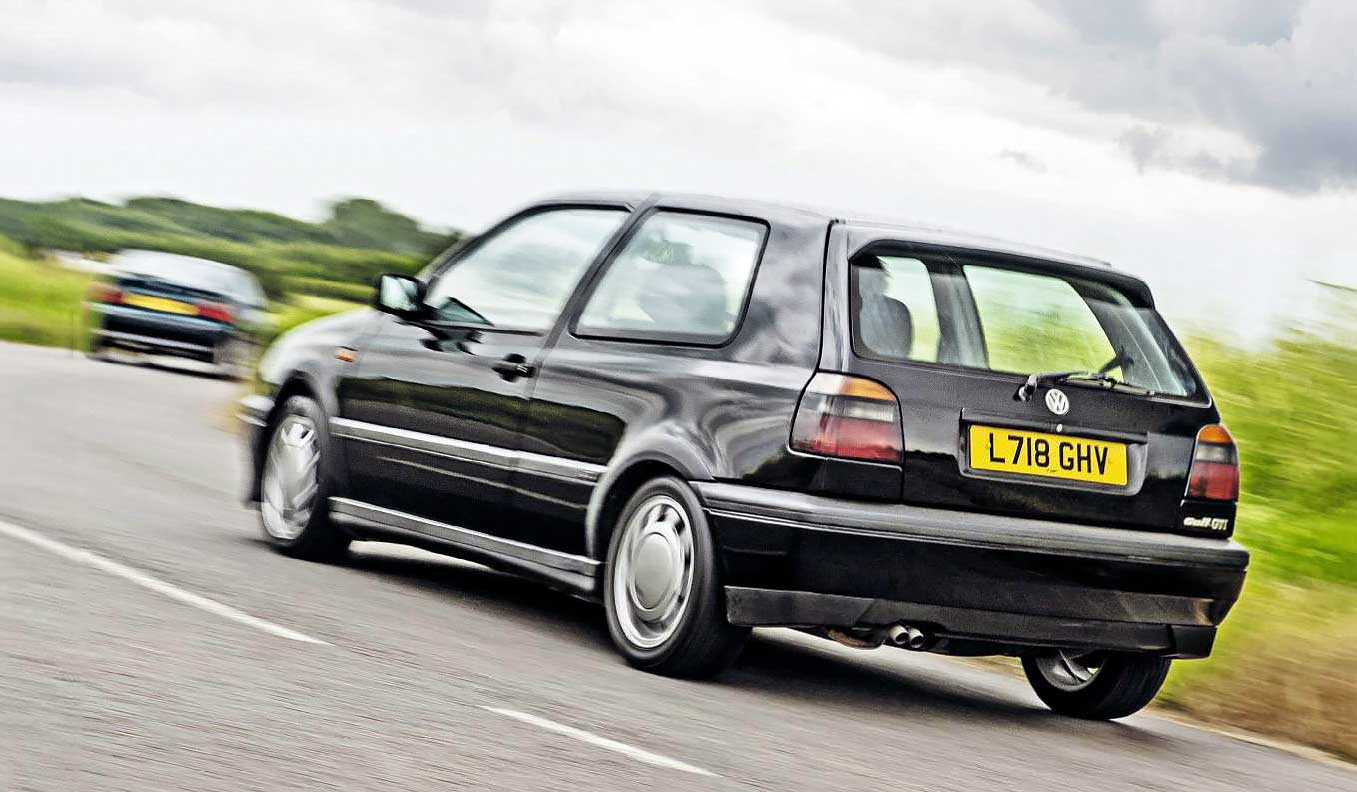
Volkswagen Golf GTi MkIII road test. Solid in its appeal, interior and handling, the GTI MkIII is the understated member of the ‘Dub clan. But there’s some fun to be had if you’re not too bothered about straight-line speed.
There’s more sobriety inside, with not a trace of tartan trim to be seen. Unlike the 318Ti, it feels built up to a certain quality, rather than down to a cost in order to allow access to the badge. The seating position is good, and the thick steering wheel and gearknob offer a decent level of tactility. On the move, it’s a very decent performer. The engine pulls keenly from low down with an engaging note, but does its best work in the mid-range. It feels like an incredibly solidly hewn machine – which is very much the case.
It’s not an animal, à la 306 GTI-6, and because of what came before it can never completely shake off those direct comparisons. While the MkI and MkII sparkle under load and effervesce through tight turns, the MkIII’s middle-aged spread is apparent when you try to keep up with the previous-generation Golf, let alone these cars here.
But lose those comparisons momentarily, and revel in the fact that it’s a blimmin’ able performer. It’s not a tyresmoking hooligan, more a grown-up hard man with nothing to prove, and it starts to make a great deal of sense. There’s a growing following for MkIIIs, but the headline grabbers will always remain the 16-valve and six-cylinder-engined variants. Long may that continue, because it means the 8V can continue to come in under the radar –just as it always has – and be bought for bargain money.

Ah, so you’ll be wishing for a VR6 here when you get the MkIII on the road. But don’t despair, because it’s fast enough – and it won’t matter once it’s lowered.
BUYING INTEL
‘An 8v is a bit flat compared to a 16v,’ says Daniel Orme of Stoke-based specialist, Deutsche Doktors (deutschedoktors.co.uk). ‘But if your budget is tight, you’re still getting a decent car.
‘You can pick up a decent runner for £300-£400, and as long as it’s been looked after it’ll still work. Low-mileage, one-owner cars go for more.
‘Check underneath the wheelarch and sill kits, and on the boot floor, as they’re starting to rot there.
‘The engine coolant temperature and crank sensors can suffer from intermittent problems, which will cause the car to cut out. You’ll pay £50 fitted for the former and £75 for the latter.
Budget around £500 per year for MoT work. A 16v is a much better drive but will be double the price, and a VR6 Highline will be half that price again.’
SPECIFICATIONS Volkswagen Golf GTi MkIII
Engine 1984cc/4-cyl/OHC
Power 115bhp @ 5400rpm
Torque 122lb ft @ 3200rpm
Maximum speed 123mph
0-60mph 9.8sec
Fuel consumption 32-36mpg
Transmission FWD, five-speed manual
The Modern Classics view
Spending an extended amount of time with these cars serves to remind you that the 1990s were a good time for lovers of performance cars. There’s an agreeable maturity about this selection that hasn’t tainted their ability to have fun. And as most of us who like to actually use our Modern Classics, that makes them all compelling alternatives to their trailer queen progenitors. Some more than others. First to go are our pair of Germans. They’re solid and well-priced but, in both cases, you’ll drive these and will forever resent the fact they’re missing two cylinders. Sorry. Now things get tougher. But we’ll let the Alfa Romeo go next. You’ll need to modify it to make it handle well, and the styling will challenge you. There’s great specialist support to counter that – but probably not enough.
Next to go out is the Renault. We truly love this one, and it drives in a way that will have you getting up an hour early just to take the long way into work. But it lacks kudos, parts can be a nightmare to get hold of and the flimsy build quality will try your patience on a daily basis.
Now, the Escort. Here’s a shock, the RS2000 is actually a good car. Almost a great one. It’s almost as dynamically sorted as the Frenchies, and easier to live with. Specialist support is great, and its mechanics are well understood. Then there’s the RS factor – it’s a relative bargain now, but don’t expect that situation to last for too much longer. And that leaves the 306 GTI-6. And its margin of victory here is surprising. It’s a brilliant car dynamically, and looks near perfect – and despite what the naysayers claim it’s well made, too. There’s good specialist support, and a clear precedent in terms of value growth with the 205 before it. The only fly in the ointment is PSA’s appalling parts supply for it. Otherwise, it proves once and for all that now’s the time to give 1990s hot hatches our full respect.
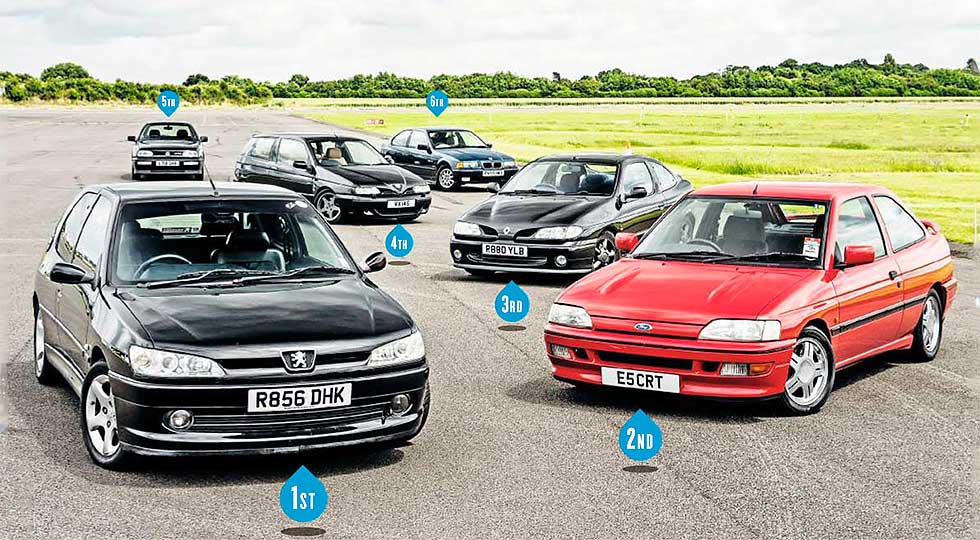
They might all be winners for the 1990s cause, but the 306GTI-6 stands above the rest. Time to go out and buy one…
{CONTENTPOLL [“id”: 76]}
‘There’s an agreeable maturity about this selection of hot hatches that hasn’t tainted their ability to go out and have a serious amount of fun’
Thanks to The owners, Alfa Aid (alfaaid.co.uk), Stuart Taylor, Malcolm Bailey, Alasdair Worsley, David Stone, Liam Kelly, Anthony Burrage, Milestone Classics (milestoneclassics.co.uk), Jamie Cripps, Matthew and Lucy Jobling, Pug1off (pug1off.com), Renault Owners’ Club (renaultownersclub.com), Ian Jordan, General Cars Ltd (020 8759 2464), RS Owners’ Club (rsownersclub.co.uk)





